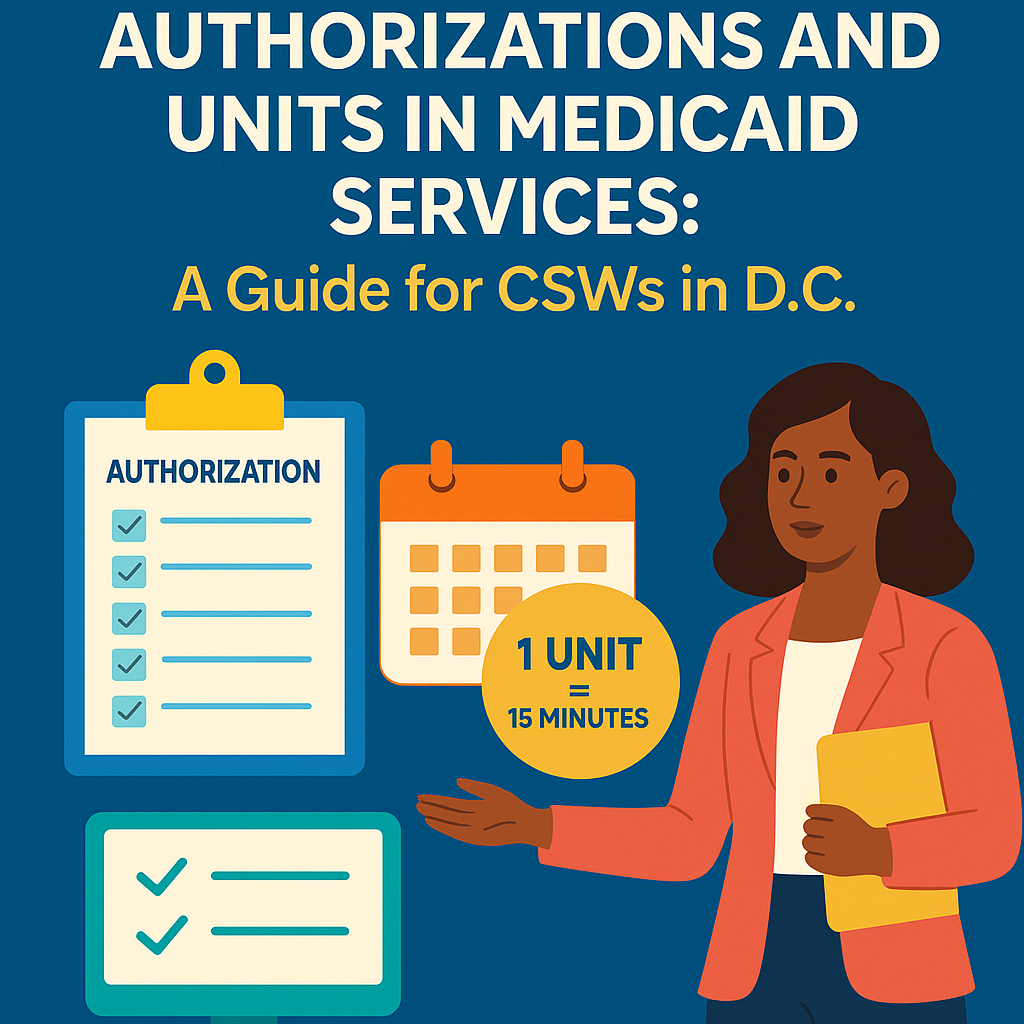Authorizations and Units in Medicaid Services: A Guide for CSWs in D.C.

Community Support Workers (CSWs) are the backbone of Medicaid-funded community care in Washington, D.C. You’re often the first line of support for individuals navigating behavioral health challenges, housing instability, and life transitions. But as of mid-2025, a critical shift has begun to reshape how you do your work: a major reduction in authorization units—the lifeblood of billing, service delivery, and ultimately, how you’re compensated.
This article is designed to help you understand these changes, plan effectively, and continue making a meaningful impact, even as resources tighten.
What Are Units and Authorizations?
In Medicaid Community Support Services, authorizations determine the number of billable service units a CSW is approved to use over a 6-month treatment plan.
Each unit = 15 minutes of documented service.
So, 4 units = 1 hour of client engagement.
These units translate directly into:
-
How many times you can meet with a consumer (client)
-
How much you are paid for those services
-
What gets reported for Medicaid compliance
The Shift: From 600 to 100 Units in Less Than 3 Years
Here’s what’s changed:
-
Early 2022: CSWs were typically approved for 600 units per 6 months.
-
2023-2024: Units were reduced to 300, then 200.
-
June 2025: Dropped to 100 units
-
Briefly restored to 200 units.
-
September 2025: probable return to 100 units.
These cuts stem from a nationwide push by Medicaid to reduce fraud, waste, and abuse—a policy shift aimed at optimizing cost-efficiency, but one that has undeniably altered the fieldwork of CSWs.
The Impact: What Unit Cuts Mean for CSWs
Let’s be direct:
Fewer units = Fewer client visits = Less compensation = Greater pressure to prioritize your work.
A reduction from 600 to 100 units means you now have only 25 hours of authorized service to stretch over a 6-month period—compared to the 150 hours you may have had in the past. This change challenges you to be more strategic than ever in how you schedule, document, and deliver care.
How to Budget Units Wisely
Scenario A: 100 Units Over 6 Months
You have 100 units (25 hours) to allocate. Consider these options:
-
1 visit/week for 3 months (about 30 minutes per session = 2 units)
→ Use ~24 units/month × 3 = 72 units, leaving 28 units for follow-ups, crisis calls, or extra check-ins. -
2 visits/month for 6 months (45 mins each = 3 units)
→ 6 months × 6 units = 36 units total, giving you room for flexibility, phone support, or high-need periods.
Scenario B: 200 Units Over 6 Months
You now have 50 hours of time. Some ideas:
-
1 hour/week for 4 months
→ 4 units/week × 4 weeks × 4 months = 64 units
→ Remaining 136 units can be spread over two months or used for targeted follow-ups, in-home visits, or care coordination. -
30-minute weekly visits for 6 months
→ 2 units/week × 24 weeks = 48 units
→ Leaves a healthy 152 units for structured interventions, documentation, or flexible outreach.
Strategies for Making Every Unit Count
-
Prioritize High-Impact Goals
Focus on what will truly move the needle—housing applications, medication adherence, transportation access, or job readiness. -
Combine Interventions
Deliver multiple services in one visit (e.g., housing support + symptom check-in) to maximize time and documentation value. -
Educate Clients for Self-Management
Use sessions to build client skills and confidence in managing tasks independently, reducing need for repeat sessions. -
Document Thoroughly
Make your notes reflect the depth and quality of your work. Medicaid audits are based on what’s written—not what’s done. -
Use Technology Tools
Tools like the Inspire Webapp (Buams.ai) allow you to:-
Track unit usage in real-time
-
Plan client schedules based on remaining units
-
Generate strong, compliant documentation
-
Stay organized and audit-ready
-
A Final Word: Your Work Still Matters
Yes, the landscape is shifting. But this isn’t the first time Community Support Workers have had to adapt—and it won’t be the last. Your role remains essential. With smart planning, strategic documentation, and meaningful interventions, you can continue to deliver high-quality support—even with fewer units.
At InspireWebapp, we’re here to walk with you, offering the tools and knowledge to make your time count. Because even when resources are reduced, your impact doesn’t have to be.
Explore tools that help you track units, plan efficiently, and document smarter—only at www.inspirewebapp.com
Articles
Build your awareness and get inspired with our researched articles on how you can strengthen your well-being
Contact Us
-
InspireWebApp
-
support@inspirewebapp.com
-
7600 Georgia Avenue Northwest, Washington, DC 20012, USA
Streamline Your Workflow with Inspire — Subscribe Now!
Join hundreds of healthcare professionals who trust Inspire to manage their documentation faster and more accurately.
Key Benefits
- ✅ Instant access to all tools
- ✅ Secure & HIPAA-compliant
- ✅ Designed for health Care providers
Popular Articles

Run Operations More Efficiently in Modern Healthcare Clinics
By Zukane Mbuih

Patient Self-Service Options for Modern Clinics
By Zukane Mbuih

Automated Scheduling and Reminders for Clinics
By Zukane Mbuih

Predictive Recovery Technology in Washington DC
By Zukane Mbuih